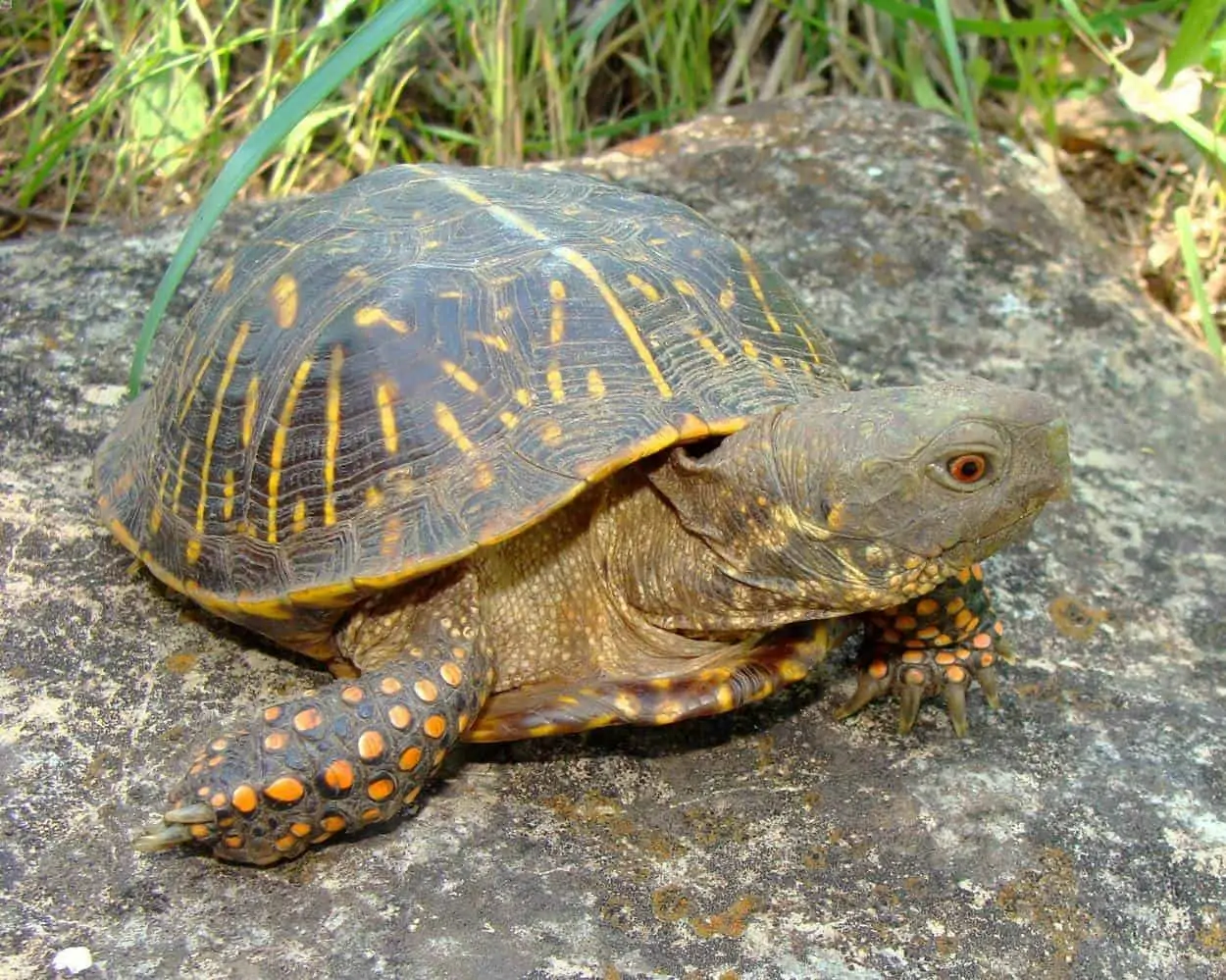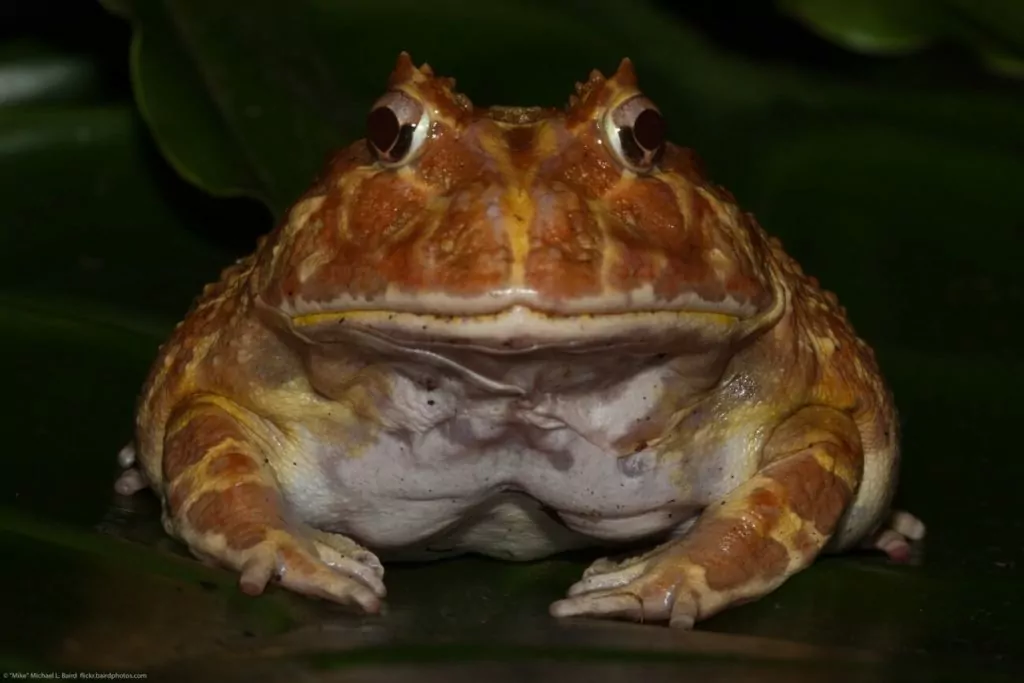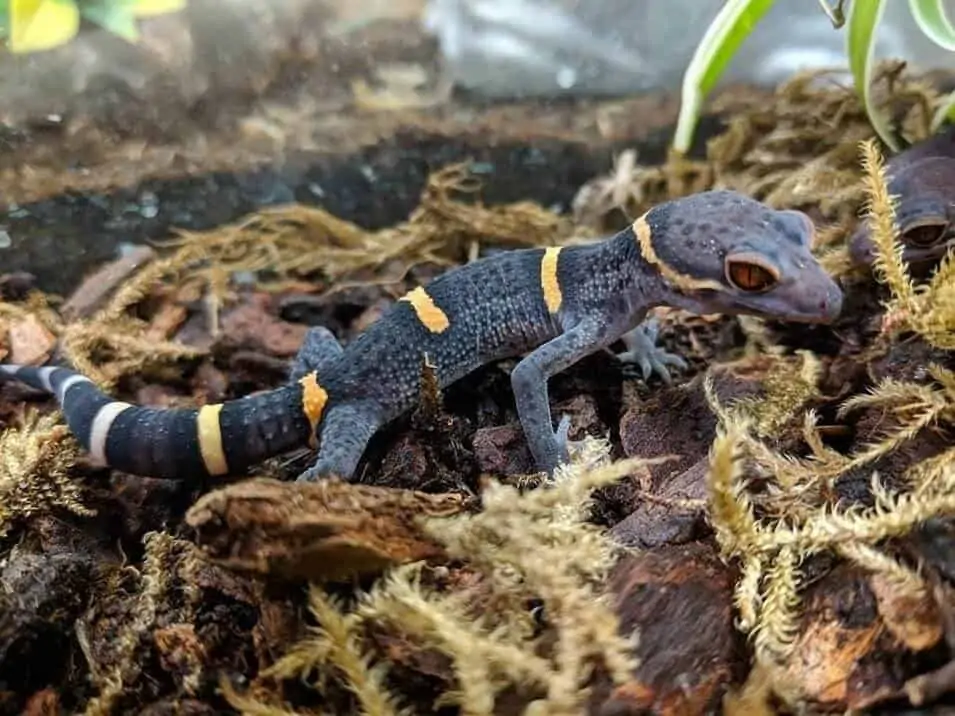Ornate box turtles are beautiful reptiles and very entertaining pets to own. With their high level of activity and lovely pattern, you won’t be able to stop yourself from watching these little creatures!
But these reptiles aren’t the easiest pets to care for. In fact, if you think about owning one we highly recommend that you have some experience first.
This guide will teach you the essentials when it comes to ornate box turtle care. We cover their diet, habitat, size, lifespan, and a ton of other useful facts!
Table of Contents
Species Summary
The ornate box turtle (Terrapene ornata ornata) is native to grassland areas in states such as Kansas, Iowa, Indiana and Nebraska. In fact, the ornate box turtle is the official state reptile of Kansas!
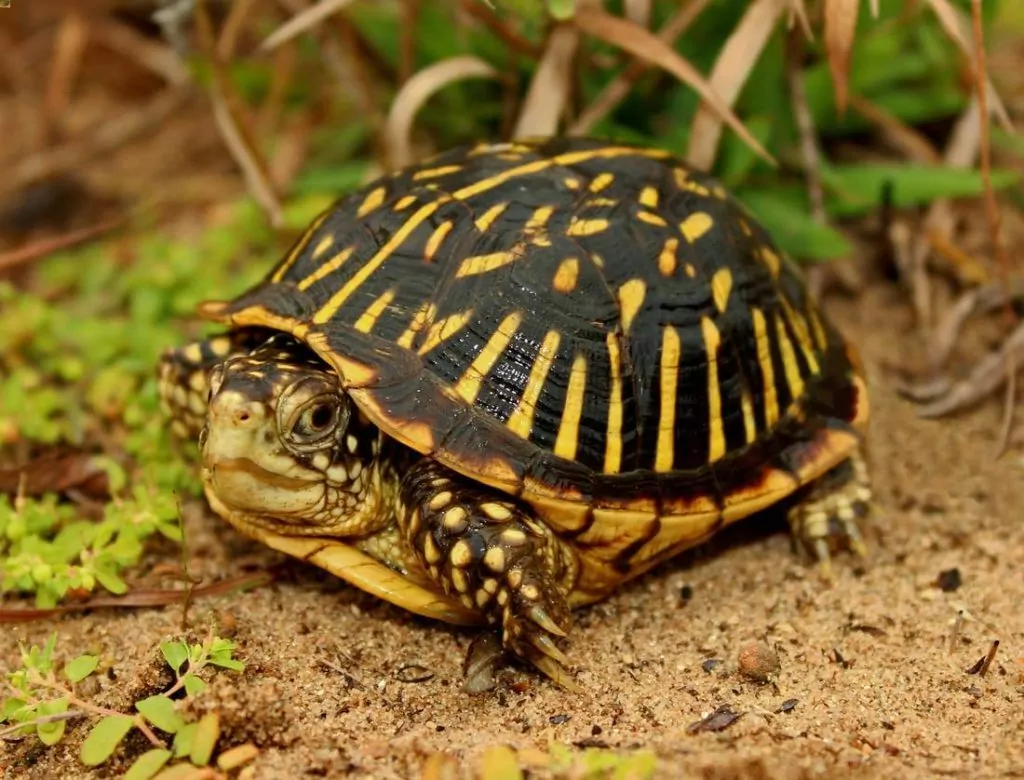
This special little turtle is one of two terrestrial turtles found in this part of the United States, and this makes it quite attractive to reptile aficionados. For many owners, dealing with an aquatic setting is unfamiliar (and requires more time than they want to spend).
Despite this, ornate box turtles are known to be difficult to care for. That’s why we recommend that only very experienced reptile caretakers should attempt to own one of these reptiles!
Appearance & Colors
The ornate box turtle has its share of good looks. Its chocolate brown shell is splashed with stripes of bright yellow that form a type of starburst pattern. The body can be gray or brown and has white or yellow spots.
Other distinguishing features include a domed shell, a curved inner claw on its back feet and red irises. These turtles also have quite a distinguished face that makes them super cute! Their beak protrudes a fair amount as well.
Expert Tip: Female ornate box turtles are typically larger than the males and have eyes that are a bit lighter in color. On the other hand, males have thicker and longer tails.
Lifespan
The typical ornate box turtle lifespan can reach up to 37 years when given good care and proper conditions. That makes owning one a long-term commitment that you shouldn’t take lightly.
It’s worth noting that poor care will drastically shorten their lifespan. If you purchase your ornate box turtle from a low-quality seller, that can also result in a pet that won’t live as long.
Average Size
The average ornate box turtle size is between five and seven inches at maturity. That makes them a fairly reasonable reptile to own in terms of size.
However, it is a bit deceptive.
Don’t let this size fool you into thinking that the ornate box turtle can thrive in a small living space. This turtle requires a pretty large enclosure (despite its diminutive size).
Ornate Box Turtle Care
Ornate box turtle care can be a very fun and rewarding experience. However, it’s best suited for anyone with a more advanced knowledge of reptile husbandry.
This tiny turtle has lots of particular temperature, dietary, housing and handling requirements that don’t make them the best choice for beginners. We wouldn’t consider them to be an “expert only” species, but definitely an intermediate level pet.
Enclosure Size
Technically speaking, the best place to set up an enclosure for your ornate box turtle is outside. Of course, this is only possible if you live in a place where the weather and temperature match the turtle’s natural climate.
If you live where you are able to keep your turtle outside, then you’ll be able to create a large set-up with plenty of room for your turtle to wander, burrow, climb and explore. A good size for an adult’s enclosure would be about 16 square feet.
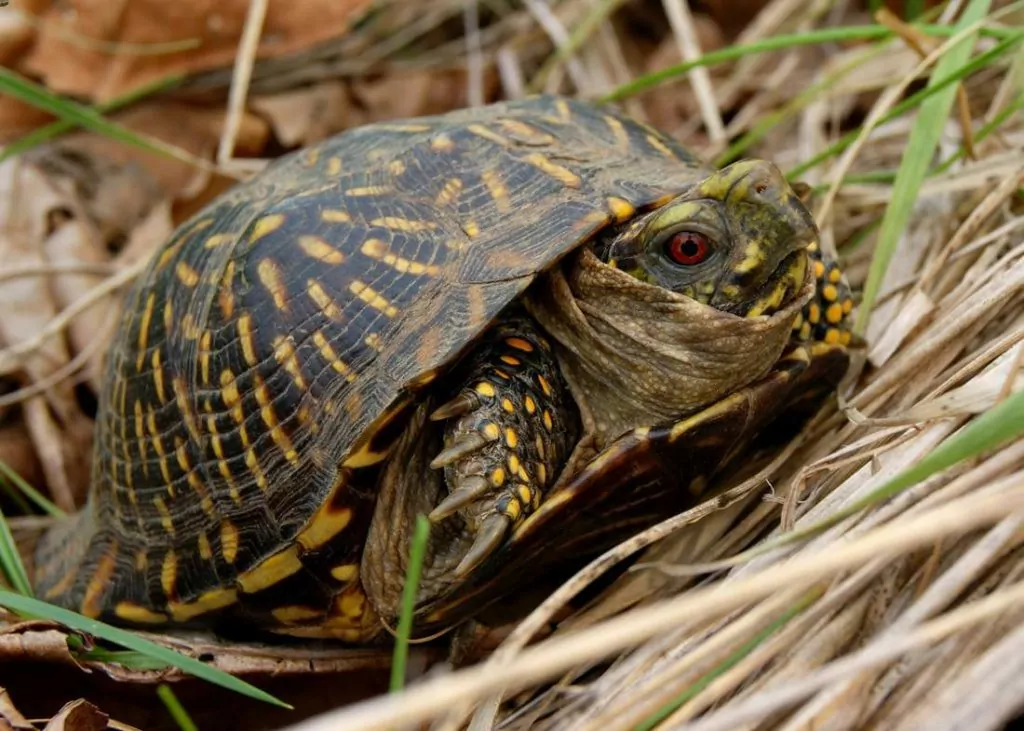
Try to make the enclosure out of material that is not easy to climb because your turtle will climb the sides and try to escape. Place your enclosure where it will get morning and afternoon sunshine.
Because these guys like to burrow, it’s suggested that the walls of the enclosure are buried deep enough to prevent your turtle from burrowing under and escaping.
Expert Tip: Also, make sure you have a tight fitting lid if you’re setting up an outdoor enclosure. Ornate box turtles love to climb, and a secure lid will help to keep them in their enclosure if they climb near the top. A lid will also help to keep them safe from predators.
If having your turtle outside is not possible, then you can certainly create a nice living space for them indoors. Again, do whatever you can to make sure that it is roomy enough and has a tight fitting lid. A 50 gallon plastic tub works well, but you can use anything that will give your turtle enough space.
Habitat Setup
Even though your ornate box turtle will have the same basic requirements whether it’s housed inside or outdoors, the habitat setup may be slightly different.
Let’s start off with the substrate. No matter where you house your ornate box turtle, they are going to need a nice, thick substrate layer for burrowing, cooling off and hiding.
For an indoor enclosure, you can use something like peat moss, sphagnum moss, soil or a combination of these items. To avoid potential respiratory issues, don’t use pine or cedar chips.
If you are housing your ornate box turtle outside, you will still need to give them that nice, comfy substrate layer. You can use top soil, cypress mulch, or mosses.
Expert Tip: Outdoor turtle enclosures can really benefit from a small compost pile. This will provide added moisture, a nice place to burrow and maybe even a free supply of tasty prey items.
As far as enclosure enhancements go, outdoor living spaces will benefit from lots of plants like turtle-safe grasses and shrubs. Plants will give your ornate box turtle nice, shady hiding places, and they will make your turtle feel safer.
Depending on the size of your indoor enclosure, you could also add some small, live plants. Again, plants help retain moisture, provide hiding spots and add beauty and interest to the space.
Other enclosure enhancements include reptile hides, rocks and pieces of wood.
Temperature & Lighting
The temperature within the enclosure should remain between 80 and 90 degrees Fahrenheit during the day.
At night, the temperature needs to be around 70 to 75 degrees Fahrenheit.
Sunshine should provide the needed heat in an outdoor situation, but some type of a heat lamp is going to be required in an indoor enclosure. Place the heat source at the basking end of your set-up away from where your turtle could get burned.
Outdoor turtles will receive all of the UVB light that they need from the sun. However, indoor turtles require some kind of supplemental UVB lighting. You can use a fluorescent bulb or a mercury vapor bulb to provide this type of necessary lighting.
Humidity
Ornate box turtles don’t need a very high level of humidity inside their enclosure. They do best with a level that’s kept between 40 to 50 percent.
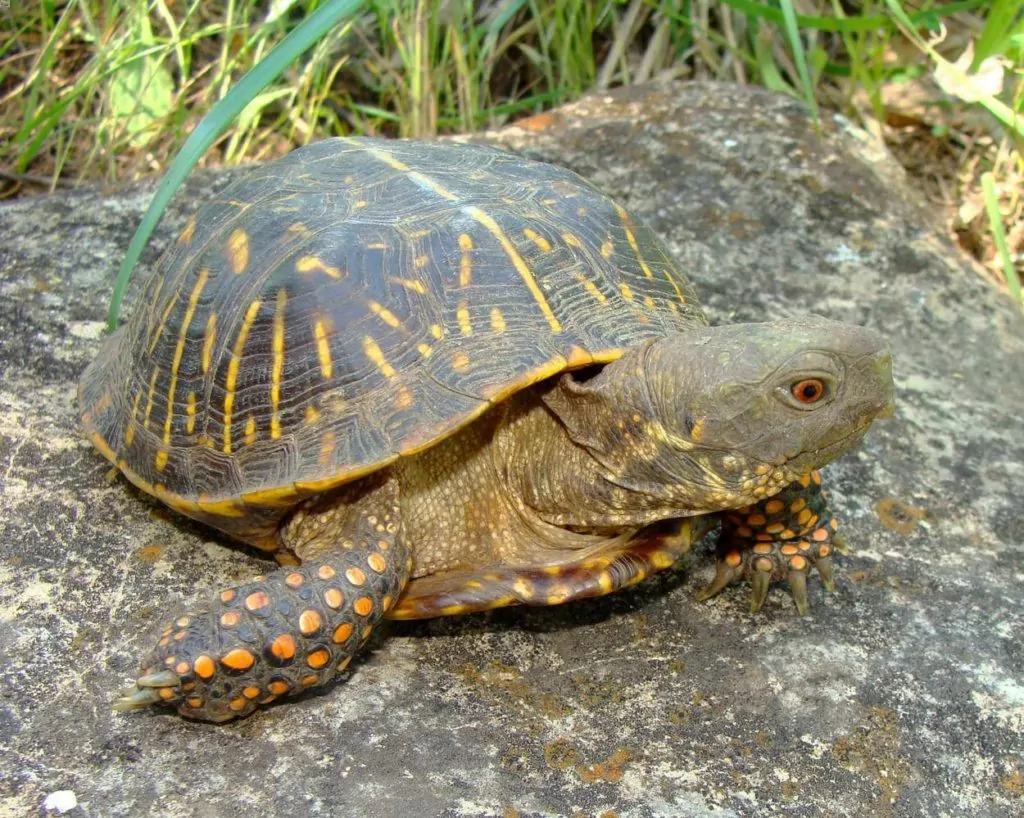
Moist leaves can provide humidity in outdoor enclosures, and daily misting and a good substrate will help maintain these levels in indoor enclosures.
Expert Tip: Make sure to invest in a reliable hygrometer so you can monitor the humidity level throughout the day. This will make it easy for you to know what adjustments you need to make in order to keep the humidity consistent!
Water
Your ornate box turtle doesn’t spend very much time in the water (unlike a lot of other kinds of pet turtles).
In fact, it really only uses water for drinking. This means having a supply of fresh and clean drinking water in their habitat is going to be important. This applies to both outdoor and indoor living spaces.
It will be your job as the owner to make sure that the water bowl is kept clean and free of food or other debris. Filthy water can quickly lead to bacterial buildup and a slew of potential health problems for your ornate box turtle.
Ornate Box Turtle Food & Diet
Being omnivores, ornate box turtles eat a variety of insects, fruits, vegetables and protein items. Some good choices include gut-loaded insects like crickets, grasshoppers, mealworms and earthworms.
You can also give them canned cat food, hard boiled eggs and ground beef. Don’t forget the greens and fruit! Berries, collard greens, mushrooms and melon are all good choices that will provide some balance to their diet.
Expert Tip: In order to provide all the nutrients an ornate box turtle needs, it’s a good idea to dust insects with a supplemental vitamin and calcium powder. Don’t go overboard with this though!
Potential Health Issues
Ornate box turtles are susceptible to a wide variety of health issues. Some of these issues include parasitic infestations, respiratory infections, shell rot and stress-related issues.
Fortunately, most of these are quite preventable if you provide your pet with good care and a proper habitat. It’s always easier to prevent health complications than treat them!
It’s also a good idea to connect with a local veterinarian who has extensive experience with reptiles (turtles in particular). If something serious ever occurs, you’ll be glad you know who to call.
Behavior & Temperature
When ornate box turtles are comfortable and happy, they are active, spunky and lots of fun to watch. This high level of activity is made even more entertaining when you factor in just how pretty they are!
However, ornate box turtles are very easily stressed. Overhandling, an insufficient diet, poor habitat conditions, or any other little fluctuation in their environment can cause a dangerous level of stress.
Ornate box turtles do not like to be handled (more on that below). If you push your luck these turtles will not hesitate to give you a pretty painful bite if they are stressed or feel threatened.
Handling Them
Ornate box turtles do not like to be handled at all, and the best thing is to just leave them alone and enjoy watching them. We only suggest handling them when it’s absolutely necessary.
Two situations for this are when you’re doing a deep clean of their enclosure or if you need to take them to the vet.
Handling will lead to elevated levels of stress which can lead to a myriad of health issues. Some ornate box turtles, especially wild-caught ones, can even die from over-stress.
Conclusion
Ornate box turtle care might be a bit tricky, but it’s definitely worth the effort. These stunning pets are a joy to own (and observe).
Don’t hesitate to reach out if there’s anything else you’d like to know about these reptiles. We love sharing and chatting with our readers!

